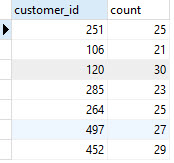August 1, 2023
Summary: In this tutorial, you will learn how to use the PostgreSQL COUNT() function to count the number of rows in a table.
Table of Contents
PostgreSQL COUNT function overview
The COUNT() function is an aggregate function that allows you to get the number of rows that match a specific condition of a query.
The following statement illustrates various ways of using the COUNT() function.
COUNT(*)
The COUNT(*) function returns the number of rows returned by a SELECT statement, including NULL and duplicates.
SELECT
COUNT(*)
FROM
table_name
WHERE
condition;
When you apply the COUNT(*) function to the entire table, PostgreSQL has to scan the whole table sequentially.
If you use the COUNT(*) function on a big table, the query will be slow. This is related to the PostgreSQL MVCC implementation. Because multiple transactions see different states of data at the same time, there is no direct way for COUNT(*) function to count across the whole table, therefore PostgreSQL must scan all rows.
COUNT(column)
Similar to the COUNT(*) function, the COUNT(column) function returns the number of rows returned by a SELECT clause. However, it does not consider NULL values in the column.
SELECT
COUNT(column)
FROM
table_name
WHERE
condition;
COUNT(DISTINCT column)
In this form, the COUNT(DISTINCT column) returns the number of unique non-null values in the column.
SELECT
COUNT(DISTINCT column)
FROM
table_name
WHERE
condition;
We often use the COUNT() function with the GROUP BY clause to return the number of items for each group. For example, we can use the COUNT() with the GROUP BY clause to return the number of films in each film category.
PostgreSQL COUNT function examples
Let’s use the payment table in the sample database for the demonstration.

PostgreSQL COUNT(*) example
The following statement uses the COUNT(*) function to return the number of transactions in the payment table:
SELECT
COUNT(*)
FROM
payment;
Here is the output:

PostgreSQL COUNT(DISTINCT column) example
To get the distinct amounts which customers paid, you use the COUNT(DISTINCT amount) function as shown in the following example:
SELECT
COUNT (DISTINCT amount)
FROM
payment;

PostgreSQL COUNT() with GROUP BY clause
To get the number of payments by the customer, you use the GROUP BY clause to group the payments into groups based on customer id, and use the COUNT() function to count the payments for each group.
The following query illustrates the idea:
SELECT
customer_id,
COUNT (customer_id)
FROM
payment
GROUP BY
customer_id;
Here is the partial output:

PostgreSQL COUNT() with HAVING clause
You can use the COUNT function in a HAVING clause to apply a specific condition to groups. For example, the following statement finds customers who have made more than 40 payments:
SELECT
customer_id,
COUNT (customer_id)
FROM
payment
GROUP BY
customer_id
HAVING
COUNT (customer_id) > 40;

In this tutorial, you have learned how to use the PostgreSQL COUNT() function to return the number of rows in a table.
See more
PostgreSQL Tutorial: Aggregate Functions
PostgreSQL Documentation: Aggregate Functions

